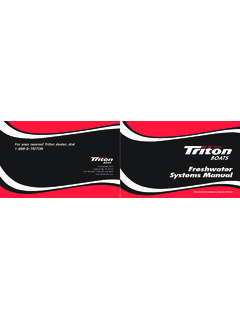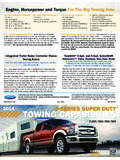Transcription of How Long do Fiberglass Boats Last?
1 How long do Fiberglass Boats Last? The same feature that helped launch the Fiberglass boat industry in the 1960s may be hurting new boat sails now. According to a boat /US Magazine, Jan, 2006 article, In 2004, 71% of Boats changing hands were pre-owned, as compared to 63% in 1997, according to a recently released study by the National Marine Manufacturers Association (NMMA). The 2004 Pre-Owned boat Market Study reported that more than one million used Boats were sold in 2004 and more than 75% of first-time boat buyers bought a used boat . The durability of Fiberglass Boats forces the industry to innovate each year with new product features and styling to attract buyers. But just what can we say is the expected lifespan of a Fiberglass boat hull?
2 The answer varies with type of construction, choice of materials, and overall workmanship. However, since we are reaching the 50-year milestone for some venerable classes of Boats that are actively being used, we can step back in time with some of these Boats that have either been maintained over the years or recently restored to get a feel for how long these structures hold up in a marine environment. Shields #231 We know that wood eventually rots and steel corrodes at a set allowance per year. Maintenance is key to achieving even normal life expectancy with wood or metal Boats . However, Fiberglass hulls have been pulled from out of the weeds and up from the depths to be restored to original luster. A case in point is the salvage of Shields #231, which sank in 60 feet of water in 1999 when swamped by a long Island Sound Easterly.
3 She was floated again on October 2, 2002. Figure 1 shows the boat as it was hauled from the bottom and Figure 2 shows her restored with a new paint job. The boat went on to race competitively in her fleet. Figure 1 Pictures of Salvaged and Restored Shields Hull # 231 Many owners of or shoppers for old Fiberglass Boats realize that the hulls themselves often outlive the wood trim and mechanical systems - which we all know can be a lot more costly to replace. It s true that the very early Fiberglass boatbuilders were conservative with their laminate schedules, which perhaps has contributed to the longevity of some classes. The reason solid skin laminate were 3/8 to inches thick was because the laminates of the time had what we would today consider to be poor mechanical properties.
4 Coast Guard 40 foot Patrol boat An example is the US Coast Guard 40 foot patrol boat that was developed in the early 1950s for law enforcement and search and rescue missions. The Boats are 40 feet overall with an 11 foot beam and displace 21,000 pounds. Twin 250 horsepower diesel engines produced a top speed of 22 knots. Single skin FRP construction was reinforced by transverse aluminum frames, a decidedly conservative approach at the time of construction. Laminate schedules consisted of alternating plies of 10 ounce boat cloth and 1 ounce mat at 3/4 inch for the bottom and 3/8 inch for the sides. In 1962, Owens-Corning Fiberglass and the Coast Guard tested panels cut from three Boats that had been in service 10 years. In 1972, more extensive tests were performed on a larger population of samples taken from CG Hull 40503, shown in Figure 3, which was being retired after 20 years in service.
5 It should be noted that service included duty in an extremely polluted ship channel where contact with sulfuric acid was constant and exposure to extreme temperatures occurred during one fire fighting episode. Total operating hours for the vessel was 11,654. Visual examination of sliced specimens indicated that water or other chemical reactants had not entered the laminate. The comparative physical test data is presented in Table 1. Table 1 Physical Property Data for 10 Year and 20 Year Tests of USCG Patrol boat [Owens-Corning Fiberglas, Fiber Glass Marine Laminates, 20 Years of Proven Durability] Hull CG 40503 10 Year Tests 20 Year Tests Average psi 5990 6140 Tensile Strength Number of samples 1 10 Average psi 12200 12210 Compressive Strength Number of samples 2 10 Average psi 9410 10850 Flexural Strength Number of samples 1 10 Average psi 6560 6146 Shear Strength Number of samples 3 10 Figure 3.
6 USCG Hull 40503 [Owens-Corning Fiberglas, Fiber Glass Marine Laminates, 20 Years of Proven Durability] triton A Northrop and Johnson ad in the Aug '60 "Yachting" cites the triton sailboat as being introduced in Jan l959. Sales to June 1960 were listed at 173 at a production schedule of 3 Boats per week. The listed price was $9590 for the sloop. Everett Pearson developed the construction standards for Fiberglass : We designed the hull laminate from the waterline down so that the boat , laid over on its side with the entire weight of the boat resting on the keel and one square inch of the hull would yield not more than 1/2 inch and produce no structural damage to the boat . This is part of the reason so many of the early Tritons are still sailing today.
7 Figure 4. Two Classic triton Sloops [ ] FiberGlassics Although old, restored Fiberglass Boats seem to blend well with the timeless designs typical of New England builders, some Fiberglass powerboats hardly blend with today s styles. Sure you have a classic Bertram in the mix but some of the older powerboat classics took their styling cues quite literally from Detroit. Figure 5. For an amusing trip down memory lane, visit the web site , shown in Figure 5. There are many examples of the early Glastrons and other powerboats. The web site shows one of the most exotic and sought after of the Glassics. It is a 1956 Lone Star, Meteor. The pink boat shown is at the end of a multiyear restoration and is of the highest quality.
8 The boat cost $1, new, about 3 times the price of an ordinary 15 foot boat . The motor and trailer were sold separately, typical of the time period. The '56 was the most detailed and expensive Meteor made and is the most collectible, subsequent years were cheapened with less trim and bench seats in an attempt to improve sales. The boat s designer, Bob Hammond, left Lone Star in 1956 to found Glastron. Many of these classics from the 50s and 60s are being restored these days, showing that the composite structure long outlives contemporary styling. Figure 6. Carp DeVille from page 4 of Boats in the Belfry- the KevFin Collection [ galleries/ ] Most gel coat on 50-year old Fiberglass Boats won t restore to showroom quality shown in Figure 6.
9 Restored Fiberglass Boats of this era are now typically painted with polyester urethane topcoat, such as Awlgrip. However, we re still concerned about how long the mechanical properties of the pure laminate can last. Keep in mind that the part of the structure that will invariably fail first is not somewhere in the middle of a hull panel but at the edges where it is attached to hardware or bulkheads. Again, good selection of attachment methods and workmanship can drastically increase the life expectancy of an FRP structural detail. Submarine Fairwaters A while back, the Navy wanted to know how the strength of submarine composites was holding up. The Navy had developed a Fiberglass replacement for the aluminum fairwaters that were fitted on submarines.
10 The fairwater is the hydrodynamic cowling that surrounds the submarine's sail. The motivation behind this program was electrolytic corrosion and maintenance problems. The laminate used consisted of style 181 Volan glass cloth in a general purpose polyester resin that was mixed with a flexible resin for added toughness. Vacuum bag molding was used and curing took place at room temperature. The fairwater installed on the Halfbeak was examined in 1965 after 11 years in service. The physical properties of the tested laminates are shown in Table 2. After performing the tests, the conclusion that the materials were not adversely affected by long term exposure to weather was reached. It should be noted that a detailed analysis of the component indicated that a safety factor of four was maintained throughout the service life of the part.




